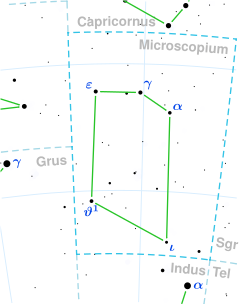| Observation data Epoch J2000.0 Equinox J2000.0 (ICRS) | |
|---|---|
| Constellation | Microscopium |
| Right ascension | 20h 40m 19.82792s[1] |
| Declination | −33° 25′ 54.6462″[1] |
| Apparent magnitude (V) | 5.47±0.01[2] |
| Characteristics | |
| Evolutionary stage | red giant branch[3] |
| Spectral type | K1 III[4] |
| U−B color index | +1.08[5] |
| B−V color index | +1.12[5] |
| Astrometry | |
| Radial velocity (Rv) | 14.2±2.8[6] km/s |
| Proper motion (μ) | RA: +21.953 mas/yr[1] Dec.: +34.487 mas/yr[1] |
| Parallax (π) | 13.5581 ± 0.0691 mas[1] |
| Distance | 241 ± 1 ly (73.8 ± 0.4 pc) |
| Absolute magnitude (MV) | +1.17[7] |
| Details | |
| Mass | 1.4±0.1[8] M☉ |
| Radius | 11.5[9] R☉ |
| Luminosity | 43.7+3.1 −2.9[10] L☉ |
| Surface gravity (log g) | 2.46±0.34[11] cgs |
| Temperature | 4,681±122[12] K |
| Metallicity [Fe/H] | −0.02[13] dex |
| Rotational velocity (v sin i) | <1[14] km/s |
| Age | 3.4±0.6[8] Gyr |
| Other designations | |
| Database references | |
| SIMBAD | data |
HD 196737, also designated as HR 7893, is a solitary orange hued star[17] located in the southern constellation Microscopium. It has an apparent magnitude of 5.47,[2] allowing it to be faintly visible to the naked eye. The object is located relatively close at a distance of 241 light years based on Gaia DR3 parallax measurements,[1] but is receding with a heliocentric radial velocity of 14.2 km/s.[6] At its current distance, HD 196737's brightness is diminished by 0.14 magnitudes due to interstellar dust.[18] It has an absolute magnitude of 1.17.[7]
This is an evolved giant star with a stellar classification of K1 III.[4] HD 196737 is estimated to be 3.4 billion years old based on asteroseismologic measurements,[8]enough for it to cool and expand onto the red giant branch; it is now fusing a hydrogen shell around an inert helium core.[3] It has 1.4 time the mass of the Sun[8] and an enlarged radius of 11.5 R☉.[9] It radiates 43.7 times the luminosity of the Sun[10] from its photosphere at an effective temperature of 4,681 K.[12] HD 196737 has a solar metallicity — what astronomers dub chemical elements heavier than helium. The star has a projected rotational velocity too low to be measured accurately.[14]
- ^ a b c d e Cite error: The named reference
GaiaDR3was invoked but never defined (see the help page). - ^ a b Cite error: The named reference
Tycho2000was invoked but never defined (see the help page). - ^ a b Cite error: The named reference
Jones2011was invoked but never defined (see the help page). - ^ a b Cite error: The named reference
Houk1982was invoked but never defined (see the help page). - ^ a b Cite error: The named reference
Oja1970was invoked but never defined (see the help page). - ^ a b Cite error: The named reference
Gontcharov2006was invoked but never defined (see the help page). - ^ a b Cite error: The named reference
Anderson2012was invoked but never defined (see the help page). - ^ a b c d Cite error: The named reference
Aguirre2020was invoked but never defined (see the help page). - ^ a b Cite error: The named reference
Kervella2004was invoked but never defined (see the help page). - ^ a b Cite error: The named reference
Charbonnel2020was invoked but never defined (see the help page). - ^ Cite error: The named reference
AP1999was invoked but never defined (see the help page). - ^ a b Cite error: The named reference
Stassun2019was invoked but never defined (see the help page). - ^ Cite error: The named reference
McWilliam1990was invoked but never defined (see the help page). - ^ a b Cite error: The named reference
De Medeiros2014was invoked but never defined (see the help page). - ^ Cite error: The named reference
Gould1879was invoked but never defined (see the help page). - ^ Cite error: The named reference
SIMBADwas invoked but never defined (see the help page). - ^ Cite error: The named reference
Eggleton2008was invoked but never defined (see the help page). - ^ Cite error: The named reference
Gontcharov2017was invoked but never defined (see the help page).
